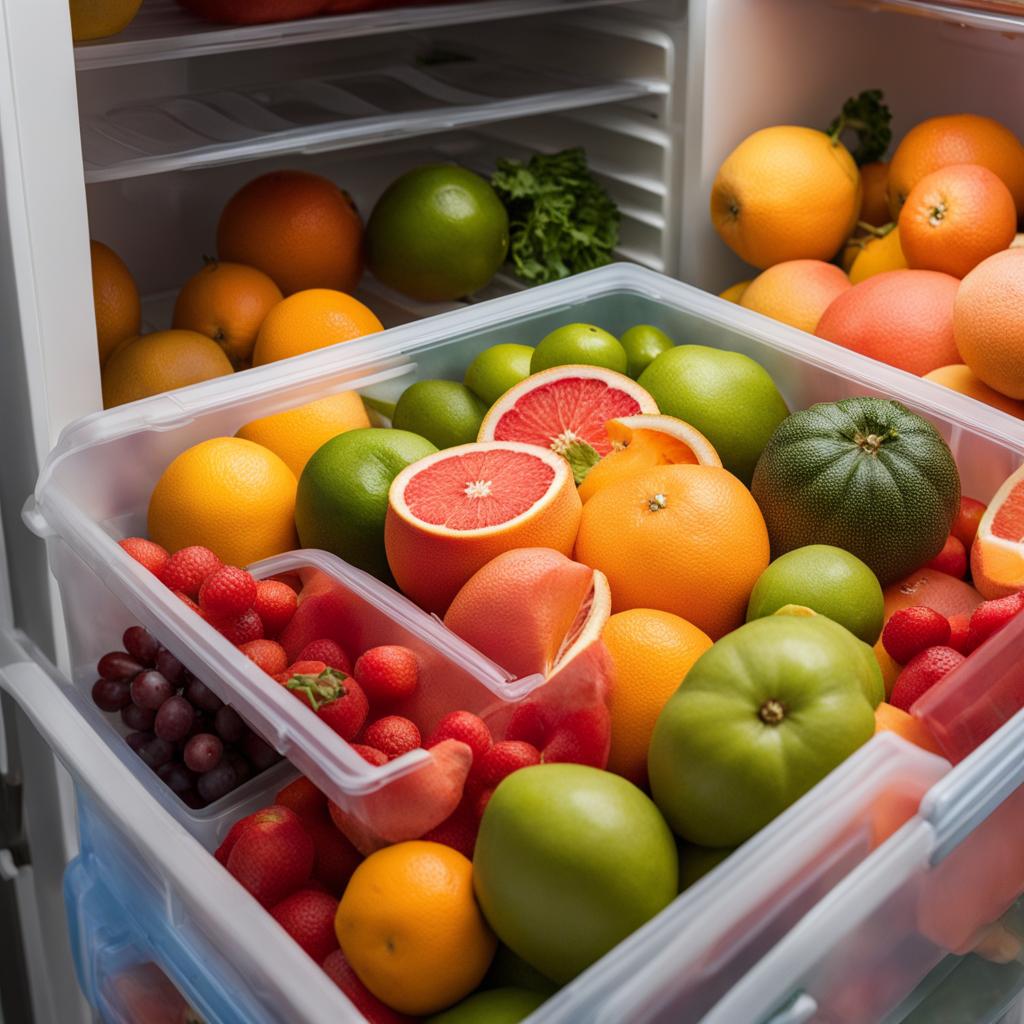Grapefruits are a delicious and refreshing fruit known for their tangy flavor and numerous health benefits. However, just like any other fruit, grapefruits can go bad. It’s important to be able to identify the signs of spoilage to ensure you are consuming fresh and safe fruit.
When it comes to determining if grapefruit is bad, there are several signs of spoilage to look out for. These include:
- Rot or mold
- Soft texture or water leaking
- Off or stale smell
- Too long storage time
Additionally, if the grapefruit has dry and shriveled skin, dark spots, or an unpleasant odor, these are clear indications that the fruit has spoiled. It’s important to trust your senses and discard any grapefruit that shows these signs of spoilage to ensure food safety.
Key Takeaways:
- Signs of spoilage in grapefruit include rot, mold, a soft texture, water leakage, an off or stale smell, and dry and shriveled skin.
- Trust your senses and discard any grapefruit that shows these signs to ensure food safety.
- Proper storage techniques can help extend the shelf life of grapefruit.
- Select high-quality grapefruits and store them properly to minimize the risk of consuming spoiled fruit.
- Enjoy fresh and delicious grapefruit by paying attention to visual cues and following storage guidelines.
Shelf Life of Grapefruit
When it comes to the shelf life of grapefruit, it’s important to understand how storage conditions can affect its freshness and longevity. Proper storage can help prolong the shelf life of grapefruit and ensure that it remains delicious and nutritious for as long as possible.
Whole grapefruits can last around a week at room temperature. However, to extend their shelf life, it’s recommended to store them in the refrigerator. When refrigerated, whole grapefruits can last 2-3 weeks. Cut or sliced grapefruits, on the other hand, have a shorter shelf life and should be consumed within 3-4 days when stored in the fridge.
To summarize the shelf life of grapefruit:
- Whole grapefruits at room temperature: About 1 week
- Whole grapefruits in the refrigerator: 2-3 weeks
- Cut or sliced grapefruits in the refrigerator: 3-4 days
It’s important to note that these timeframes may vary depending on the freshness of the grapefruit and storage conditions. Be sure to inspect the fruit for any signs of spoilage before consuming.
Table: Shelf Life of Grapefruit
| Grapefruit Type | Room Temperature | Refrigerator |
|---|---|---|
| Whole Grapefruit | About 1 week | 2-3 weeks |
| Cut or Sliced Grapefruit | N/A | 3-4 days |
How to Select a Fresh Grapefruit
When it comes to choosing a fresh grapefruit, there are a few key factors to consider. By paying attention to these factors, you can ensure that you are selecting a grapefruit of the highest quality.
Weight and Texture
First, take note of the weight of the grapefruit. A fresh grapefruit should feel heavy in your hand, indicating that it is full of water and freshness. Avoid grapefruits that feel light or hollow, as this can be a sign of water loss and decreased quality.
In addition, consider the texture of the grapefruit. A fresh grapefruit should be firm to the touch. Avoid fruits that have a soft or mushy texture, as this can indicate spoilage.
Appearance
Next, examine the appearance of the grapefruit. Look for fruits that have smooth skin, free of any sunken spots, bruises, or blemishes. These imperfections can accelerate the deterioration of the fruit’s quality.
Color is also a visual indicator of freshness. Depending on the variety, grapefruits can range in color from yellow to pink or red. Choose grapefruits with vibrant, rich hues, as they are likely to be the freshest.
Fragrance
Finally, consider the fragrance of the grapefruit. A fresh grapefruit will have a refreshing citrus scent. If the grapefruit smells off or unpleasant, it may be an indication that it is no longer fresh.
By selecting grapefruits that are heavy, firm, free of blemishes, and have a refreshing scent, you can ensure that you are choosing the best quality fruit for your enjoyment.
Visual Signs of Spoiled Grapefruit
When it comes to identifying spoiled grapefruit, visual cues play a crucial role. By observing the appearance of the fruit, you can determine whether it is still safe to consume. Here are the key visual signs of spoilage to watch out for:
- Rot or Mold: Check for any signs of mold or rot on the surface of the grapefruit. Mold can appear as fuzzy, discolored patches, while rot may cause the fruit to become mushy or disintegrate.
- Soft Texture and Water Leaking: A spoiled grapefruit may feel soft and have a squishy texture. Additionally, if you notice any water leaking from the fruit, it is a clear indication of spoilage.
- Dark Spots and Dry, Shriveled Skin: Inspect the grapefruit for any dark spots or blemishes on the skin. These can be signs of decay. Furthermore, if the fruit’s skin appears dry and shriveled, it is likely past its prime.
By recognizing these visual signs, you can make an informed decision about whether to consume or discard the grapefruit. Trusting your senses and exercising caution when it comes to spoiled fruit is essential for maintaining food safety.
Signs of Spoiled Grapefruit: Odor
When it comes to determining if grapefruit is spoiled, one of the key signs to look out for is the odor. An off or stale smell, especially in cut-up grapefruit that has been stored in the refrigerator, is an indication that the fruit has gone bad. The scent will be unpleasant and can be quite distinct, making it easy to identify. Trust your sense of smell and if the grapefruit emits an unpleasant odor, it is best to discard it to ensure food safety.
Grapefruit that has spoiled can harbor harmful bacteria, fungi, and yeasts, which can lead to foodborne illnesses. Consuming spoiled grapefruit can be a health risk, so it’s important to prioritize food safety and discard any fruit that shows signs of spoilage, including a foul odor.
How to Store Grapefruit
Proper storage is key to maintaining the freshness and flavor of grapefruit. Follow these guidelines to ensure your grapefruits stay in optimal condition:
Refrigeration
Grapefruits can be stored in the refrigerator to extend their shelf life. Place whole grapefruits in the crisper drawer, sealed in plastic bags to prevent moisture loss. When stored properly, they can stay fresh for up to 2-3 weeks. Cut or sliced grapefruits should also be stored in the refrigerator, in resealable containers or bags, and consumed within 3-4 days.
Room Temperature
If you plan to consume grapefruits within a few days, it is safe to store them at room temperature. Keep whole grapefruits in a cool, dry, and dark place, such as a pantry. Place them in a fruit bowl or open basket to allow for adequate ventilation. Remember that the shelf life of grapefruits stored at room temperature is shorter compared to refrigeration.
Avoid Moisture and Direct Sunlight
To maintain the quality of grapefruits, it’s important to keep them away from excessive moisture and direct sunlight. Excess moisture can lead to mold growth, while sunlight can cause the fruit to deteriorate more quickly. Store grapefruits in a dry environment, and avoid placing them near windows or other sources of direct sunlight.
By following these storage recommendations, you can enjoy fresh and delicious grapefruits for an extended period. Proper storage not only preserves the taste and texture of the fruit but also ensures your safety by minimizing the risk of spoilage.
How Long Can Grapefruit Last
When it comes to the shelf life of grapefruit, it’s important to consider various factors such as storage conditions and the type of grapefruit. Whole grapefruits can typically last for about a week at room temperature. However, by refrigerating them, you can extend their freshness and shelf life to 2-3 weeks. Cut or sliced grapefruits have a shorter shelf life and can be kept in the refrigerator for 3-4 days.
It’s worth noting that these timeframes are estimates and can vary depending on the freshness of the fruit and storage conditions. To ensure that your grapefruits last as long as possible, it’s essential to store them properly. This includes keeping whole grapefruits in the crisper drawer of your refrigerator, sealed in plastic bags. As for cut or sliced grapefruits, they should be stored in resealable containers or bags in the refrigerator to maintain their quality.
By following these storage guidelines, you can enjoy the deliciousness of grapefruits for an extended period, while minimizing the risk of consuming spoiled fruit.
| Grapefruit Type | Storage Time at Room Temperature | Storage Time in the Refrigerator |
|---|---|---|
| Whole grapefruit | Up to 1 week | 2-3 weeks |
| Cut or sliced grapefruit | N/A | 3-4 days |
Table: Shelf life of grapefruit based on storage conditions.
Safe Consumption of Grapefruit
When it comes to enjoying grapefruit, it’s crucial to prioritize food safety. Consuming spoiled grapefruits can lead to foodborne illnesses, so it’s important to know the signs of spoilage and how to ensure safe consumption. Trusting your senses and being aware of proper storage techniques can help you avoid consuming spoiled grapefruit.
Signs of Spoilage: One of the key indicators of spoiled grapefruit is the presence of rot or mold. If you notice any fuzzy or discolored patches on the fruit, it’s best to discard it. Another sign of spoilage is a soft and mushy texture or water leaking from the fruit. Fresh grapefruit should have a firm texture and no signs of moisture. Additionally, pay attention to the odor of the grapefruit. If it has an off or unpleasant smell, it’s a clear indication of spoilage.
Proper Disposal: If you come across a grapefruit that shows signs of spoilage, it’s important to discard it to ensure your safety. Do not try to salvage the fruit by cutting away the spoiled parts, as this can lead to cross-contamination. It’s better to be safe and eliminate any risk of consuming contaminated grapefruit.
Enjoying Fresh Grapefruit: To ensure safe consumption, always opt for fresh and properly stored grapefruit. Select grapefruits that feel heavy in your hand and have smooth skin free of blemishes. Store whole grapefruits in the refrigerator for longer shelf life, and sliced or cut grapefruits in airtight containers. By following these guidelines, you can enjoy the delicious taste and health benefits of grapefruit while minimizing the risk of consuming spoiled fruit.
| Signs of Spoiled Grapefruit | Safe Consumption Tips |
|---|---|
| Presence of rot or mold | Discard grapefruit showing signs of spoilage |
| Soft, mushy texture or water leaking | Avoid salvaging spoiled parts |
| Off or unpleasant odor | Select fresh grapefruit and discard any with an odor |
| Properly dispose of spoiled grapefruit | Store whole grapefruit in the refrigerator |
| Enjoy fresh and properly stored grapefruit | Store sliced or cut grapefruit in airtight containers |
How to Determine Freshness of Grapefruit
Assessing grapefruit freshness is essential to ensure you’re enjoying a high-quality fruit. By paying attention to visual and sensory cues, you can confidently select the freshest grapefruits for your consumption.
Visual Cues
One way to determine the freshness of grapefruit is by observing its appearance. Look for vibrant colors, ranging from shades of yellow to pink or red. A fresh grapefruit should have smooth and glossy skin, free from blemishes or discoloration. Avoid fruits with sunken spots or bruises, as these can indicate spoilage.
When assessing a grapefruit’s freshness, take note of its texture as well. A fresh grapefruit will feel firm and resilient when gently pressed. Avoid fruits that feel overly soft or mushy, as this can be a sign of deterioration.
Sensory Cues
The scent of a grapefruit can also provide valuable information about its freshness. When you cut into a fresh grapefruit, it should emit a refreshing and invigorating citrus aroma. Avoid grapefruits with a sour or pungent odor, as this can indicate spoilage.
By combining these visual and sensory cues, you can easily determine the freshness of a grapefruit before consuming it. Remember to trust your instincts and discard any grapefruits that show signs of spoilage to ensure your safety and enjoyment.

Proper Storage of Grapefruit: Room Temperature
Storing grapefruit at room temperature can be a convenient option if you plan to consume the fruit within a few days. When stored properly, grapefruits can maintain their freshness and quality for up to 10 days at ambient temperature. To ensure optimal storage conditions, it’s important to follow a few guidelines.
Storing Whole Grapefruits
If you have whole grapefruits, you can store them in a cool, dry, and dark place, such as a pantry or fruit bowl. It’s recommended to choose a location with adequate ventilation to allow airflow, which can help extend the shelf life of the fruit. You can place the grapefruits on a mesh bag or open basket to facilitate air circulation and prevent excessive moisture buildup.
Preventing Spoilage
To prevent spoilage and maintain the freshness of grapefruits stored at room temperature, it’s essential to monitor the fruit regularly. Check for any signs of mold, rot, or soft spots, and discard any grapefruits that show these spoilage indicators. It’s also important to keep the grapefruits away from direct sunlight and heat sources, as they can accelerate the ripening process and lead to quality deterioration.
Best Practices for Room Temperature Storage
When storing grapefruits at room temperature, it’s crucial to remember the following key points:
- Choose a cool, dry, and dark location with good ventilation.
- Regularly check the grapefruits for signs of spoilage, such as mold or rot.
- Keep the grapefruits away from direct sunlight and heat sources.
| Storage Method | Temperature | Shelf Life |
|---|---|---|
| Room Temperature | Ambient temperature (cool, dry, and dark place) | Up to 10 days |
| Refrigeration | Approximately 4°C (40°F) | 10-21 days |
Proper Storage of Grapefruit: Refrigeration
When it comes to extending the shelf life of grapefruit and maintaining its freshness, refrigeration is key. Storing grapefruits in the refrigerator can help them stay fresh for an extended period of time. To ensure the best quality and taste, follow these guidelines for proper storage:
Temperature and Placement
Set your refrigerator’s crisper drawer to the dry setting to maintain a consistent humidity level. This will help prevent excess moisture and mold growth on the grapefruits. Place the grapefruits in the crisper drawer, away from other fruits and vegetables. Keeping them separate will help maintain their individual flavors and prevent cross-contamination.
Packaging
It’s important to keep the grapefruits dry to maintain their quality. If the grapefruits have come in contact with water, gently pat them dry before placing them in the refrigerator. You can store the grapefruits in a sealed plastic bag or wrap them individually in plastic wrap to prevent moisture loss and maintain their juiciness. This will also help to preserve their freshness and prevent them from absorbing any odors from the refrigerator.
Shelf Life
When properly stored in the refrigerator, whole grapefruits can typically stay fresh for 10 to 21 days. However, it’s always best to check for any signs of spoilage before consuming them. If you notice any mold, rot, or an off odor, it’s best to discard the grapefruit to ensure food safety.
By following these proper storage techniques, you can enjoy fresh and delicious grapefruits for an extended period of time. Remember to store them in the refrigerator, keep them dry, and check for any signs of spoilage before consuming. Now you can savor the juicy goodness of grapefruit whenever you desire.
Proper Storage of Cut or Peeled Grapefruit
When it comes to storing cut or peeled grapefruit, it’s important to follow proper techniques to maintain the fruit’s freshness and quality. By taking the necessary steps, you can ensure that your grapefruit stays delicious and ready to enjoy.
To store cut or peeled grapefruit, it is best to place the fruit in an airtight container or wrap it tightly in plastic wrap. This helps to prevent the fruit from drying out and protects it from absorbing any odors in the refrigerator. By keeping the grapefruit properly sealed, you can extend its shelf life and ensure that it stays juicy and flavorful.
It’s recommended to store cut or peeled grapefruit in the refrigerator, as the cool temperature helps to slow down the spoilage process. This way, you can safely store the fruit for up to 7 days, allowing you to enjoy it over multiple servings. Remember to consume the grapefruit within this timeframe to savor it at its best.
| Storage Method | Duration |
|---|---|
| Refrigerator (cut or peeled grapefruit) | Up to 7 days |
Proper storage of cut or peeled grapefruit is essential for preserving its flavor and texture. By following these guidelines, you can keep your grapefruit fresh and ready for a refreshing snack or addition to your favorite recipes.

Conclusion
In conclusion, it’s crucial to know how to tell if grapefruit is bad and be aware of the signs of spoilage. By paying attention to visual cues, such as mold, texture, and odor, you can ensure the safety of your food. Additionally, proper storage techniques are essential for maintaining the freshness of grapefruit.
When selecting grapefruit, look for high-quality fruits that are heavy, firm, and have smooth skin. Avoid fruits with sunken spots or bruises, as these can accelerate spoilage. Once you have chosen your grapefruit, store it properly to prolong its shelf life.
For maximum freshness, refrigerate whole grapefruits in a sealed plastic bag or container. Cut or peeled grapefruits should also be stored in the refrigerator, tightly wrapped or in an airtight container. By following these storage guidelines and discarding any spoiled fruit, you can enjoy delicious and safe grapefruit.
FAQ
How can I tell if a grapefruit is bad?
Signs of spoilage in grapefruit include rot or mold, a soft texture or water leaking, an off or stale smell, and too long storage time. Dry and shriveled skin, dark spots, and an unpleasant odor are also indications of spoilage. Trust your senses and discard any grapefruit showing these signs.
How long does grapefruit last?
Whole grapefruits can last about a week at room temperature and 2-3 weeks in the refrigerator. Cut or sliced grapefruits can be kept for 3-4 days in the fridge. Once peeled, the storage time decreases to a couple of days.
How do I choose a fresh grapefruit?
Choose grapefruits that feel heavy, are firm to the touch, and have smooth skin without sunken spots or bruises. Look for a refreshing citrus scent and avoid grapefruits that appear hollow or light.
What are the visual signs of spoiled grapefruit?
The visual signs of spoiled grapefruit include rot or mold, a soft and mushy texture, water leaking from the fruit, dark spots, and dry and shriveled skin.
How can I tell if a grapefruit is spoiled by its odor?
An off or stale smell, especially in cut-up grapefruit stored in the refrigerator, is an indication that the fruit has spoiled. An unpleasant odor is also a clear sign of spoilage.
How should I store grapefruit?
Whole grapefruits can be stored in the crisper drawer of the refrigerator or in a cool, dry, and dark place. Cut or peeled grapefruit should be stored in the refrigerator in an airtight container or tightly wrapped in plastic wrap.
How long can grapefruit last?
Whole grapefruits can last for about a week at room temperature and 2-3 weeks in the refrigerator. Cut or sliced grapefruits can be kept for 3-4 days in the fridge.
Is it safe to consume spoiled grapefruit?
Consuming spoiled grapefruits can lead to foodborne illnesses. It’s important to prioritize food safety and discard any grapefruits or grapefruit juice that show signs of spoilage.
How can I determine the freshness of a grapefruit?
To determine the freshness of a grapefruit, consider its color, skin texture, firmness, and citrus scent. A fresh grapefruit will have vibrant colors, smooth skin, be firm to the touch, and emit a refreshing citrus scent when cut into.
How should I store grapefruit at room temperature?
Whole grapefruits can be stored in a cool, dry, and dark place, such as a pantry or fruit bowl. Adequate ventilation is important, so place them in a mesh bag or open basket to allow airflow.
How should I store grapefruit in the refrigerator?
Whole grapefruits should be stored in the crisper drawer on the dry setting. Cut or peeled grapefruit should be placed in an airtight container or tightly wrapped in plastic wrap.
How should I store cut or peeled grapefruit?
Cut or peeled grapefruit should be stored in the refrigerator in an airtight container or tightly wrapped in plastic wrap. Consume within 7 days to maintain freshness.
Source Links
- https://www.doesitgobad.com/how-long-does-grapefruit-last/
- https://boydhampers.com/blogs/guides/how-long-does-grapefruit-last-in-the-fridge
- https://homecookworld.com/how-to-tell-if-a-grapefruit-is-bad/
Related Recipes:
 Does Almond Milk Go Bad? How to Tell and Storage Tips.
Does Almond Milk Go Bad? How to Tell and Storage Tips.
 Can You Eat Expired Butter? What You Need to Know
Can You Eat Expired Butter? What You Need to Know
 Does Peanut Butter Go Bad? Shelf Life and Storage Tips
Does Peanut Butter Go Bad? Shelf Life and Storage Tips
 How to Identify Spoiled Canned Foods
How to Identify Spoiled Canned Foods
 How to Tell if Jelly Has Gone Bad: Preserving Quality
How to Tell if Jelly Has Gone Bad: Preserving Quality
 How to Store Limes to Preserve Their Freshness
How to Store Limes to Preserve Their Freshness
 How Long Can Yogurt Sit Out? Guidelines and Safety
How Long Can Yogurt Sit Out? Guidelines and Safety
 Pineapple Storage: Tips for Longevity
Pineapple Storage: Tips for Longevity








